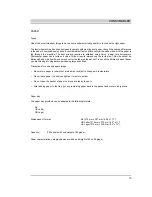
1
BEFORE USE
BEFORE USE
This manual is an essential guide for those wishing to learn how to use this facsimile machine.
The “GETTING TO KNOW THE FAX” chapter provides an overview of the product. The drawings which are
easy-to-understand and cover all aspects will help you to quickly become familiar with the product and get
the most out of your fax in no time.
The “CONSUMABLES” chapter provides information on the technical characteristics of the paper and print
cartridge.
The “PROGRAMMING” chapter describes how to set the machine to suit your requirements and explains how
to store your most frequently used facsimile and telephone numbers for fast, automatic dialling.
The “BEFORE TRANSMITTING/COPYING” chapter introduces you to transmission operations.
The “TRANSMISSION”, “RECEPTION”, “ACTIVITY HANDLING” and “COMPLEMENTARY FUNCTIONS”
chapters illustrate how to implement the most advanced features of the facsimile machine, including the
various
transmission and reception methods, use of the memory, copying, voice calls, etc.
The “REPORTS” chapter provides you with information on the transmission and reception transactions
carried out.
The “FILLING UP/ELIMINATING PAPER JAMS” chapter provides instructions on how to add paper and insert
the print cartridge. It shows in what areas paper jams are most likely to occur and how to deal with them.
The “MAINTENANCE” chapter informs you of the periodic maintenance operations required and how you can
eliminate faults by yourself.
The “SIGNALS AND SERVICE CODES” chapter describes how the machine informs you of operating errors
and provides additional information on the current operating modes.
The “CHARACTER SET TABLE” chapter shows all the alphanumeric characters that you can display and
select.
The "OPTIONS" chapter describes the additional features that can be used on the facsimile machine.
Finally, the “GENERAL FEATURES OF THE FACSIMILE MACHINE” chapter lists the technical features of
the facsimile machine.
The chapters from the “PROGRAMMING” chapter to the “REPORTS” chapter are laid out in independent
sections, each of which deals with one complete feature. The features are discussed in an order that will
enable you to learn more quickly. As they are independent of each other, they can, however, be consulted
in any order.
Each of these sections consists of:
-
An introduction with a short definition of the feature.
-
A section preceded by the
o
symbol describing the situation in which you must be in order to carry out
the procedure described (if this part is not included, the feature requires no specific conditions).
cap01.p65
13/04/00, 19.43
1












































